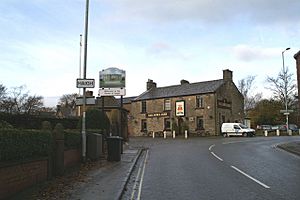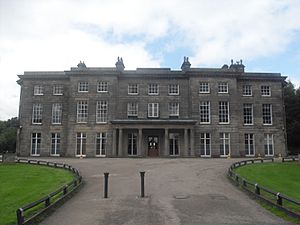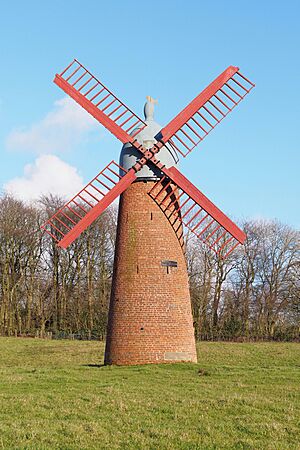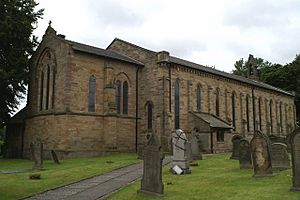Haigh, Greater Manchester facts for kids
Quick facts for kids Haigh |
|
|---|---|
 Haigh village |
|
| Population | 594 (2001) |
| OS grid reference | SD605090 |
| Civil parish |
|
| Metropolitan borough |
|
| Metropolitan county | |
| Region | |
| Country | England |
| Sovereign state | United Kingdom |
| Post town | WIGAN |
| Postcode district | WN1 / WN2 |
| Dialling code | 01257 / 01942 |
| Police | Greater Manchester |
| Fire | Greater Manchester |
| Ambulance | North West |
| EU Parliament | North West England |
| UK Parliament |
|
Haigh is a small village in Greater Manchester, England. It's a civil parish, which is a local area with its own council. Haigh is located right next to the village of Aspull. The River Douglas forms its western border, separating it from Wigan. In 2001, about 594 people lived here.
Contents
History of Haigh
The name Haigh comes from an old English word, haga. This word means "the enclosure," like a fenced-off area. Over time, the name was written in different ways, such as Hage or Hagh.
The Manor of Haigh
A "manor" was like a large estate with a lord or lady in charge. Between 1220 and 1230, Haigh was part of a big land area called the Marsey fee.
One important story from Haigh's history involves a woman named Mabel. Her father, Hugh le Norreys, was the lord of Haigh in 1282. Mabel married William Bradshagh. In 1298, they took over the manors of Haigh and Blackrod.
William Bradshagh got into trouble in 1315 during a rebellion. He was declared an outlaw, and his lands were taken away. People thought William had died, so Mabel remarried. But then, William returned in 1324 and sadly killed Mabel's new husband. William himself was killed in 1333.
A famous legend says that Mabel felt very sorry for what happened. As a way to show her regret, she walked barefoot from Wigan to Haigh every week for the rest of her life. This story was even written into a novel by the famous writer Sir Walter Scott. You can still see a reminder of this legend at Mab's Cross in Wigan Lane.
Later, the Bradshaigh family continued to own the manor. In 1780, Elizabeth Dalrymple, who was related to the Bradshaighs, inherited Haigh. She married Alexander Lindsay, 6th Earl of Balcarres.
The Earls of Crawford and Balcarres later moved their main home to Haigh Hall. A manor house had been on the Haigh estate for a long time. The current Haigh Hall was built between 1827 and 1840. The 7th Earl Balcarres designed and oversaw its building himself!
In 1947, the 11th Earl sold Haigh Hall and its grounds to Wigan Corporation for £18,000. Today, it's a popular country park.
Coal Mining in Haigh
In 1540, people discovered a special type of coal in Haigh called cannel coal. This coal was amazing because it could be burned for fuel or carved into beautiful ornaments. It was easy to light, burned with a bright flame, and left almost no ash. People used it for lighting their homes before gas lamps became common.
By the mid-1600s, the coal mines started to flood. To fix this, Sir Roger Bradshaw built a long tunnel called the Great Haigh Sough between 1653 and 1670. This tunnel was about a mile long and helped drain water from the mines. It still works today!
Later, the families who owned Haigh, the Earls of Crawford and Balcarres, started the Wigan Coal and Iron Company in 1865. This company owned several coal mines in Haigh, including the Alexandra and Lindsay Pits.
Haigh Foundry
The Haigh Foundry was an important iron works that opened in 1788. It made pig iron and other metal parts. From 1808, the company started making large machines like winding engines and pumps for the mining industry.
In 1812, the Haigh Foundry built Lancashire's very first train engine! They built more locomotives over the years. They even built engines for famous railways like the Great Western Railway. By 1856, they had built over 100 train engines.
In 1848, Haigh Foundry made a huge beam engine, which was possibly the largest in the world at that time. They also made massive swing bridges for docks in Liverpool and Hull, which are still there today! The foundry closed in 1885.
Governance
Haigh has always been part of Lancashire. It was a township within the larger area of Wigan. It was part of the local administration that helped manage things like support for the poor.
Geography of Haigh
Haigh's western border is the River Douglas. A small stream also separates it from Blackrod to the north. The land in Haigh rises up towards the east and north.
The village is about 2.5 miles northeast of Wigan. It sits about 520 feet (158 meters) above sea level. Haigh Hall Country Park is a large area of 250 acres with woods and parkland. To the east, you can see Winter Hill and the West Pennine Moors.
Roads connect Haigh to nearby towns like Blackrod, Standish, Wigan, and Aspull. The Lancaster Canal also runs through the western part of Haigh. The ground under Haigh is made of sandstone and shale, which is why coal and cannel coal were found and mined here.
Population of Haigh
In the 2001 census, the village of Haigh had a population of 594 people.
Landmarks
The Haigh Windmill is the only windmill left in Greater Manchester. It was built in 1845. It used to pump water for a local brewery. The windmill was not used for a long time, but it was restored in 2011. This restoration cost £60,000 and was made possible with help from the Heritage Lottery Fund.
Transport
The Lancaster Canal was completed to Haigh in 1799. This canal later connected to the Leeds and Liverpool Canal. A building called a Packet House was built near the canal. It was used for sending goods, mail, and for passengers.
A railway line called the Springs Branch Railway opened in 1838. There was a train station at Red Rock which opened in 1869. This station even had a special waiting room for the people living at Haigh Hall! The station closed in 1949.
Religion
St David's Church was built in 1833. It was a "chapel of ease" for the main church in Wigan. This means it was a smaller church built to serve people who lived far from the main church. In 1838, Haigh and Aspull became their own church parish. The Roman Catholic Church of Our Lady of the Immaculate Conception opened in 1858.





